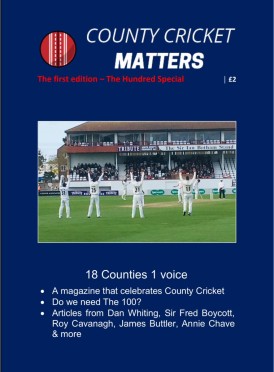County Cricket Matters
Martin Chandler |Published: 2019
Pages: 36
Author: Various
Publisher: Opposethe100
Rating: 5 stars

Back in the 1970s I took my first tentative steps into licensed premises. It was not a wholly pleasurable experience. There was a constant fear of my true age coming to light and being asked to leave and, to be honest, the beer I got to drink was pretty filthy stuff. Not so many years previously British ale had had an excellent reputation, but by the time I started to imbibe the choice was generally between a sour continental lager or keg beers that were little more than fizzy water with a dash of alcohol and an unpleasant taste.
At about the same time I slowly became aware of CAMRA, the Campaign for Real Ale. As the 1970s became the 1980s CAMRA, an organisation that is still with us, has proved to be the most successful pressure group there has ever been. Craft beers and micro breweries have meant that the big brewers have had to raise their game to the same level and the result is that today’s beer drinkers are faced with a product that is infinitely superior to anything that was available in my youth.
Which brings me on to the subject of county cricket, for years the envy of the world. The game was at a new level as I grew up, the traditional dominance of the so-called ‘big six’ having been broken by the introduction of overseas players. The County Championship, not without its problems admittedly, sat comfortably alongside three one day competitions. In recent years we have seen three day matches extended to four and the 18 First Class counties split into two divisions. I had and have reservations about both those developments but, ultimately, believe they have proved to be changes for the better.
In recent seasons T20 fever has gripped the counties. Most traditionalists hated its arrival, and some still do. Rather more of us have grown to accept it as a necessary evil and, even though we don’t like having to do so, will reluctantly admit to occasionally enjoying it. For me it has been the development of the format into a genuine contest between bat and ball rather than a batting exhibition that has clinched it, and I have also been gratified to see some of the smaller counties from the lower reaches of the second division able to compete with those from the top flight on level terms.
But the county game, the bedrock of professional cricket and the precursor of the international game is in grave danger. The ECB have decided to embark on a new project, the much vilified ‘Hundred’, which they seem to believe is capable of matching the IPL in its money making capabilities. In doing so they appear to have ignored the fact that, irrespective of the degree to which their speculative venture succeeds or fails, they will destroy the Championship forever. If they do so Test cricket will not be far behind on the road to oblivion.
There are many who have complained bitterly and vociferously about this hugely worrying development, but individual entreaties and pleas have fallen on deaf ears. Against that background and in the spirit of CAMRA a group of brave souls have banded together to form County Cricket Matters and the group have now published this booklet, which amounts to their mission statement.
The booklet begins with an editorial from James Buttler who neatly summarises the issues. Dan Whiting expands on that start before Jeremy Lonsdale looks at some lessons from history and Annie Chave makes a plea from the heart. There are various other contributors as well, a particular highlight being the forthright and entertaining views of that man of the people from Pudsey, Sir Fred Boycott.
So why does County Cricket Matters get five stars? It is not simply because this reviewer is wholly behind the sentiments expressed by the writers, although complete objectivity in that situation is not easy. The standard of the writing is good, and the production standards impressive, but the main reason for the maximum score is the clarity with which County Cricket Matters presents its case. It is not a tribal and ‘pie in the sky’ equivalent of a political manifesto. Rather it is a lucid and well presented case for how to preserve in perpetuity what makes English cricket what it is.
Who should read County Cricket Matters? Firstly that must be anyone who supports the cause. As CAMRA taught us with numbers come strength and influence. Those in the ECB who propound the hundred need to read it as well. I do not seriously question their motives, but have to say that I do have my doubts as to whether they have really thought through the consequences of their actions, or understand the very real concerns that cricket lovers have. Finally I would suggest, this time next year that there is a reprint and that, assuming they find it, the ECB’s ‘new audience’ should by read a copy as well. By doing so they will realise that there is rather more to cricket than that which they have been witnessing, and hopefully they will be encouraged to look beyond the strains of Sweet Caroline for their cricketing entertainment.
County Cricket Matters have a Facebook page, and can be contacted by email at opposethe100@gmail.com or via Twitter @opposethe100






Leave a comment